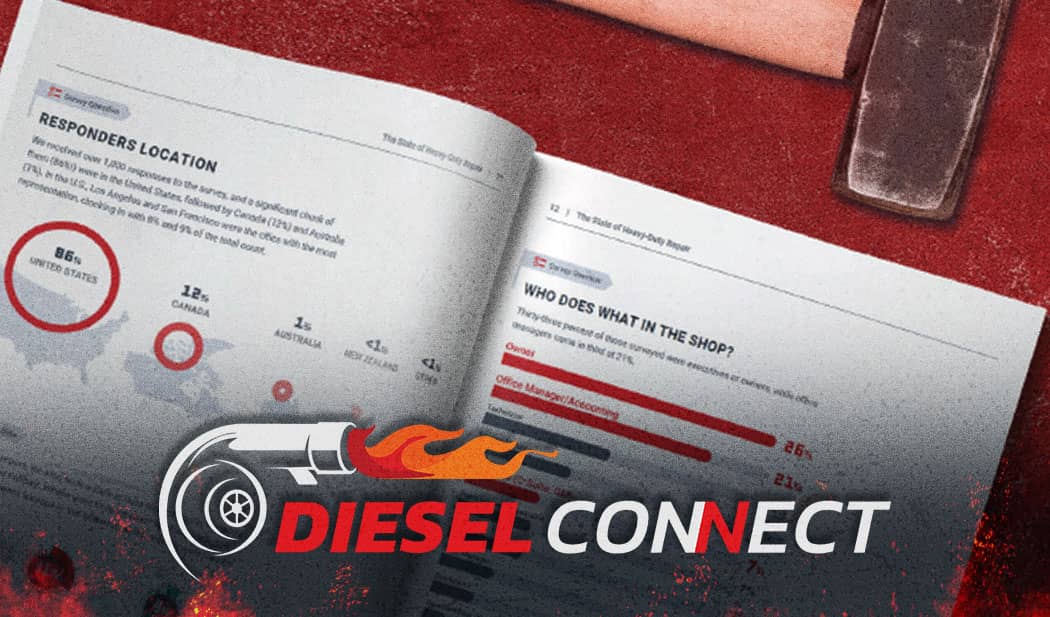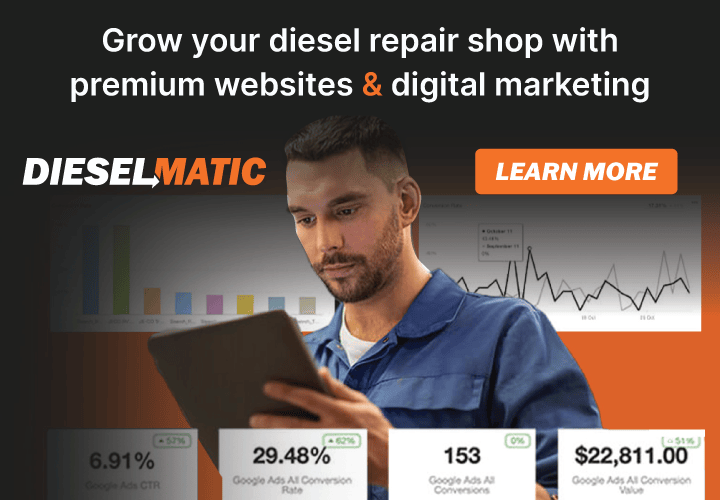Diesel Connect: The State of Heavy-Duty Parts: 2024 Edition

Day Two of Diesel Connect 2024 kicked off with a presentation everyone was looking forward to: Jamie Irvine of the Heavy Duty Parts Report and Heavy Duty Consulting Corporation. He’s also joined the guys for the Shop Owners Roundtable webinar that listeners absolutely loved.
Basically, he knows a lot about parts.
Parts are…how can we put this tactfully…extremely freakin’ important in this industry. Every piece of heavy-duty equipment out there is going to need a new part (or many new parts) at some point. Heck, it’s practically an industry unto itself. And Jamie wasn’t just at Diesel Connect to talk about how parts are doing in 2024—he also wanted to encourage shop owners to increase their revenue and grow their business by selling parts.
You can watch the entire presentation right here, right now…or, if you’re pressed for time, you can read our recap and then watch the full presentation later. We definitely recommend giving it a go, though—Jamie had so much incredible information, we just couldn’t include all of it in one teeny-tiny blog.
Let’s get into it! How is the heavy-duty parts industry faring?
THE STATE OF HEAVY-DUTY PARTS IN 2024: A BACKGROUND
It goes without saying that the last few years have been a weird ride for everyone—but the parts arena suffered particularly hard. Practically overnight, thousands of shop owners realized that “Just In Time” ordering was, well, no longer just in time.
There has been recovery, of course, and Jamie thinks things are as normal as they’re ever going to be—but they’re not going to revert to pre-COVID situations.
The pandemic laid bare the fragility of the supply chain. Don’t get us wrong, it was a super-cool supply chain: you could order a part from halfway around the world and it could be in your shop that evening.
But the world that created the conditions for that speedy parts travel has disappeared. Manufacturing has changed a lot (some factories have relocated, altered their production, or simply closed down), and volatile situations around the world can impact shipping times and even whether your parts will arrive safely.
He believes this need will culminate in a retreat from globalization, at least as far as parts and manufacturing goes—we need to have the necessary components here, in the United States, not stranded on a shipping container or in a war zone.
(Geopolitics: messing with trade since the Trojan War.)
Jamie predicts a resurgence in nearshoring or “friendshoring” to combat those problems. “We have to protect our ability to get the parts we need and keep the trucks rolling,” he said. Heavy-duty parts in particular are incredibly critical to everyday life continuing in something resembling a normal fashion.
Because what happens if the trucks stop moving?
Well…
THE HEAVY-DUTY INDUSTRY IMPACTS EVERYONE
Jamie brought out a convenient graph to show us what would happen if all the trucks just stopped. We won’t paste in the entire thing here, but as a starter:
- Within 24 hours, hospitals and grocery stores start having shortages (remember the toilet paper shortages of COVID?).
- Within three days, significant food shortages would occur, along with the beginning of health hazards (garbage just collecting on the street).
- Within a week, hospitals would run out of critical supplies like insulin and oxygen; public transit would stop entirely.
- Within two weeks, the clean water supply would start running out.
The trucks need to keep rolling. That means the parts need to be available and accessible. As nearshoring expands, parts will be available…and will need people to sell them. Granted, this is probably going to take many years, and in the meantime, still leaves us vulnerable to potential volatility in the supply chain.
BUT WHERE IS THE PARTS MARKET HEADED?
Make no mistake: the potential issues in the supply chain—along with the numerous economic challenges the country is facing—make it difficult to predict where the parts market is headed. Jamie and his analyst believe things have bottomed out, and that the market will start to recover, but it’s going to be a long-term deal. “We [may see] modest growth,” he said, “or in the worst-case scenario, we see this volatility in the next couple of years where we’re riding a bit of a roller coaster.”
At the same time, parts suppliers are looking for new businesses to partner with. We are at the end of a long cycle of consolidation—businesses gobbling each other up and becoming conglomerates—for a variety of reasons, among them the cost of capital, financial regulations, and restrictions from OEMs.
Now…the market does not like being forced into nearly identical options.
Fleets, Jamie added, are pretty sick of dealing with supermajors, too.
What happens after mass consolidation?
Independents make a comeback.
And therein lies an opportunity for some repair shops.
EXPANDING INTO THE PARTS BUSINESS: A WISE MOVE FOR THE RIGHT SHOP
Jamie has built an entire business out of helping repair shops become parts and services companies—essentially making them into parts distributors.
“Conceptually,” he told us, “it makes sense.”
Think about it: if you buy direct from parts suppliers, you can improve profitability—and possibly pass those savings along to your customers, which will give you a competitive advantage. As a service business, when you get work, you’ve got to do the work—but if someone just orders a part from you, well, you put the part in a box and ship it (or hand it over the counter). Executed properly, it can be a great way to increase revenue and grow the business.
Easy, right?
Well…no. If you want to go all in on parts sales, you’re going to have to tame the most fearsome antagonist of all: suppliers.
They are the ones that supply parts to you.
(Duh, Fullbay, you’re saying. Okay, chill, we are setting the stage here.)
Working with suppliers is how you’ll grow your shop into a proper parts and services company. But suppliers already have a lot of contacts, and sometimes those contacts squabble amongst themselves, and you appearing on their doorstep saying, “Hey, sell to me!” isn’t necessarily going to win them over.
So what will?
Jamie kindly supplied five barriers to entry you absolutely need to be able to get past if you want to look good to those suppliers:
- You need warehouse space and staff. Think delivery drivers, people to pick orders, a place to keep all those parts you’re going to order.
- You need retail space and counter staff. Gotta serve the walk-in traffic, right?
- You need outside parts sales selling to other customers. You won’t just be serving the people you repair for anymore.
- You need inventory to support the local service area. If everyone in your region is using Volvos…you need a lot of Volvo stuff.
- You need a market that is underserved. This may be geographic, or it may be specialty—if you can find a piece of the market that no one is serving, all the better. But we’ll let Jamie explain it a bit more: “If you’re in a market where there are three dealership groups, four independent parts distributors, and the competition and distribution in that area is extremely fierce, you entering as a parts distributor holds no appeal to the suppliers. It’s just watering down their distribution.”
Once you understand those barriers, you can build a business strategy around the preconditions for success.
Speaking of which…Jamie defines these as:
- Obtaining operating capital. Alas, this is at a premium these days and can be tough to acquire.
- Developing a brand and taking it to the market. “So many companies … offer identical products/services/value,” Jamie said, “so you need to be able to build a brand that over time is going to take on value in the marketplace.”
- Ability to scale and expand to multiple areas. When you sit down with a supplier, you’ll need to tell them where you’re going, how, and why. You’re giving them the information they need to manage channel conflict between OES dealers, big aftermarket distributors, and big independents—which every supplier has to do.
- Ability to take the market share from competitors. Suppliers need to see that you have a plan that can take market share from their biggest competitors.
- Develop innovative ways to add value. Yes, you want to bring value to your customers. But you’ve probably noticed a theme in these bullets: you want to bring value to the suppliers. Again, Jamie said, it strengthens their channel conversations.
If you want to transition into a parts distribution business, the ten things above are what work. Jamie, his team, and the countless businesses they’ve worked with have found that to be true.
“Not every repair business is positioned to do this,” he said, “but the ones that are—it really is worth your time and consideration.”
AND THEN…SCALE!
Jamie has a saying: The riches are in the niches.
(Man…put that on a mug.)
“People told me … ‘No one will listen to a podcast called ‘The Heavy Duty Parts Report. No one cares,’” Jamie told us. And look: everyday folks scrolling past podcasts might not click on it. But someone in the industry, or interested in it? They’re gonna click.
He applied that advice to those shop owners considering expanding into parts. There’s always going to be an underserved market that you can move into. “[That is] your entry point,” he said. “Get a foothold, get a couple suppliers working … establish legitimacy for the new parts and service business, get the brand off the ground, and then scale.”
You take your plan and your accomplishments to other suppliers.
You grow.
Take advantage of opportunities when you can.
And remember—what you do is important. Without the trucks, everything grinds to a halt.
“We go to work every day,” Jamie said to the audience. “We take care of our customers. We take care of this trucking industry—and that industry takes care of society.”
So get out there and expand, shop owners. The world is changing, and everyone’s got to do their part(s)!

